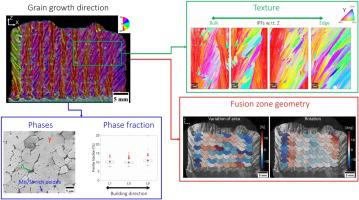Journal of Materials Processing Technology ( IF 6.7 ) Pub Date : 2021-09-14 , DOI: 10.1016/j.jmatprotec.2021.117373 L. Palmeira Belotti 1 , J.A.W. van Dommelen 1 , M.G.D. Geers 1 , C. Goulas 2 , W. Ya 3 , J.P.M. Hoefnagels 1

|
Wire arc additive manufacturing (WAAM) is a class of technologies suitable for producing large parts due to its high material deposition and building rates. Among the many possible materials processed by WAAM, austenitic stainless steels, e.g. 316L, are commonly employed. The structure of WAAM 316L thin parts has been studied extensively before. However, multiwalled or thick WAAM 316L parts remain largely unexplored. Hence, in this study, the microstructure of a thick 316LSi WAAM part is characterised in detail. The microstructure of the part consists of large and highly-oriented columnar grains dominated by epitaxial and competitive growth. The overlapping regions between neighbouring fusion zones contain long grains with a dominant <100> texture, which cross several layers and are aligned with the building direction. The grains' internal microstructure consists of an austenite matrix, ferrite with locally varying dendritic morphologies and dispersed oxide inclusions. The texture spatially varies across the part, and this variation is correlated to the local thermal gradient induced by the building strategy and processing conditions used during the manufacturing of the thick-walled part.
中文翻译:

厚壁电弧增材制造不锈钢的显微组织表征
电弧增材制造 (WAAM) 是一类适合生产大型零件的技术,因为它具有较高的材料沉积和构建速率。在 WAAM 处理的许多可能材料中,通常使用奥氏体不锈钢,例如 316L。WAAM 316L 薄型零件的结构以前已被广泛研究。然而,多壁或厚的 WAAM 316L 部件在很大程度上仍未得到探索。因此,在本研究中,对厚 316LSi WAAM 零件的微观结构进行了详细表征。零件的微观结构由大且高度取向的柱状晶粒组成,主要是外延和竞争生长。相邻熔合区之间的重叠区域包含具有主要 <100> 织构的长晶粒,这些晶粒跨越多个层并与构建方向对齐。谷物' 内部微观结构由奥氏体基体、具有局部不同枝晶形态的铁素体和分散的氧化物夹杂物组成。整个零件的纹理在空间上变化,这种变化与厚壁零件制造过程中使用的构建策略和加工条件引起的局部热梯度相关。











































 京公网安备 11010802027423号
京公网安备 11010802027423号